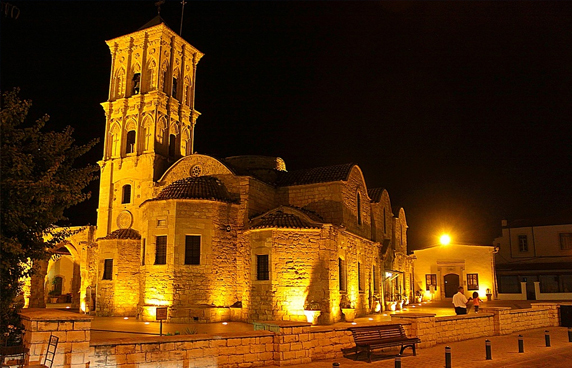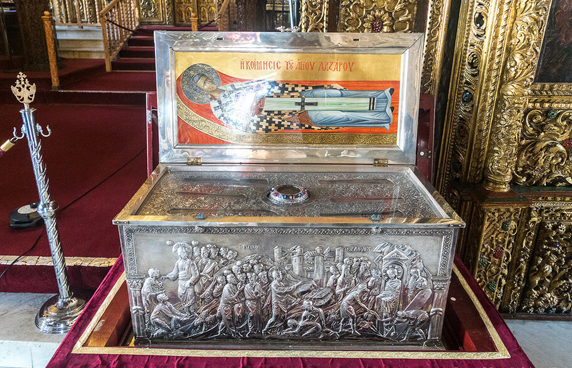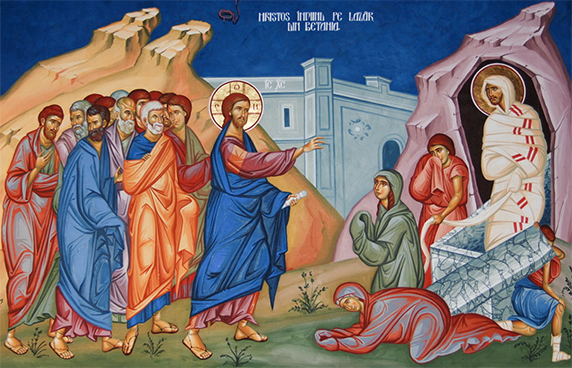Saint Damascene Studit writes that righteous Lazarus never told what he saw in hell. Seeing the torments of hell, he constantly felt bitterness in his mouth and could not eat anything without first sweetening it. Also, he never laughed. Only once, when he saw how one person stole an earthen court, he grinned and said: “Clay steals clay”, about which the church historian Nicephorus Callistus Xanthopoulos also wrote.
Jesus said, “Remove the stone.” Martha, the sister of the deceased, said to Him, “Lord, by now there will be a stench; he has been dead for four days.” Jesus said toher, “Did I not tell you that if you believe you will see the glory of God?” So theytook away the stone. And Jesus raised his eyes and said, “Father, I thank you forhearing me. I know that you always hear me; but because of the crowd here I havesaid this, that they may believe that you sent me.” And when he had said this, he criedout in a loud voice, “Lazarus, come out!” The dead man came out, tied hand and footwith burial bands, and his face was wrapped in a cloth. So Jesus said to them, “Untiehim and let him go.”Now many of the Jews who had come to Mary and seen what he had done beganto believe in him.
The gospel story of the Four-Day dead Saint Lazarus is well known to every Christian. Let’s just remember why it’s called the Four Days. After Lazarus’ death, Jesus Christ came to Bethany only on the fourth day. Omitting all the details, it is worth noting that, according to the idea of the ancient Jews, the soul is present with the body for three days, trying to enter it again, but then it leaves it forever. The mention of the fourth day in this context aims to emphasize that Lazarus’ death was final and irrevocable.
There is very little information about the righteous Lazarus, and there are many contradictions in them. Even the evangelist John writes about the very miracle of Lazarus’ resurrection. Lazarus was not mentioned in writing for fear that the Jews would kill him, because, as John the Theologian says, “And the chief priests agreed that they should kill Lazarus also” (John 12:10).
After the resurrection, Lazarus lived another 30 years, of which he spent 18 as a bishop in Cyprus, so he died in 63 AD. The first information about that can be found in the sermon of John of Euboea. Lazarus was ordained a bishop by the apostles Paul and Barnabas, who preached in Cyprus; some sources mention that the ordination was performed by the apostle Peter.

Temple of St. Lazarus the Righteous in Cyprus
After his resurrection, Lazarus did not leave any written works, only semi-apocryphal legends about him remain. Lazarus, who saw the torments of hell, felt bitterness in his mouth and could not eat anything without first sweetening it. Saint Damascene Studit writes that Lazarus never told what he saw in hell and never laughed. Only once, when he saw how one person stole an earthen court, he grinned and said: “Clay steals clay”, about which the church historian Nicephorus Callistus Xanthopoulos also wrote.
In addition, Lazarus is associated with the legend of the creation of the Salt Lake near Kiti. One version of this legend is the following: when, as a bishop, he addressed a rich woman with a request to share a part of the harvest for the needs of orphans, she replied that her fields had stopped giving. Lazarus just smiled at the madness of greed. Turning to her vineyards, the woman suddenly saw that there was a salt lake in their place. This salt lake has survived to this day, it is called “Lazarus’ Smile”.
One of the most important legends about the righteous Lazarus is the visit of the Most Holy Mother of God to him in Cyprus. It is said that Lazarus, wanting to see the Virgin Mary, sent a boat for her. The Most Holy Mother of God and the Apostle John the Theologian who accompanied her, at Lazarus’ request, set out on a journey to him. At first, the storm took their ship to Athos, but then they reached Cyprus safely. The Most Holy Mother of God gave Lazarus the hierarch’s omophorion and the handrails she sewed.
After his death, Bishop Lazarus was buried by the locals in Kition, in a marble reliquary with the inscription: “Lazarus of Four-Days, Friend of Christ”. It is mentioned that miracles and healings happened every day next to Lazarus’ relics.
In the 5th century, a large temple was built on the site of his burial, where the descent to Lazarus’ tomb was arranged. During the Arab raids, the temple was destroyed, and the locals built a small chapel in its place. Some of Lazarus’ relics were transferred to Constantinople and it is mentioned that they were built into the altar wall of the temple. Many pilgrims and eyewitnesses of these events wrote about the miracles that took place near the relics of righteous Lazarus. His honorable relics still reside there today, pouring some inexpressibly beautiful fragrance.

Relics of Saint Lazarus the Righteous in Cyprus
Just as Saint Lazarus rose and revived with the word of Christ, so everyone, even though they died, will be resurrected at the last trumpet, and will live forever – it is said in Sinaksar on Lazarus’ Saturday. Through the prayers of your friend Lazarus, Christ God, have mercy on us!

